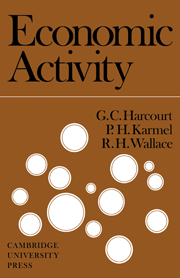Book contents
- Frontmatter
- Preface
- Contents
- 1 INTRODUCTION
- 2 THE NATIONAL ACCOUNTS AND THE INCOME–CREATION PROCESS
- 3 THE PRODUCTION–INCOME–EXPENDITURE CIRCUIT AND NATIONAL ACCOUNTING IDENTITIES
- 4 THE DETERMINATION OF THE EQUILIBRIUM LEVEL OF REAL INCOME
- 5 THE CONCEPT OF FULL EMPLOYMENT
- 6 MONEY IN THE ECONOMIC PROCESS
- 7 THE BANKING SYSTEM AND THE QUANTITY OF MONEY
- 8 THE CONSUMPTION FUNCTION
- 9 THE DETERMINANTS OF INVESTMENT EXPENDITURE
- 10 THE EFFECT OF CHANGES IN EXPENDITURE PLANS: THE MULTIPLIER CONCEPT
- 11 THE GOVERNMENT SECTOR AND THE DETERMINATION OF REAL INCOME
- 12 THE OPEN ECONOMY
- 13 THE INTERACTION BETWEEN PLANNED EXPENDITURES AND FINANCIAL FACTORS
- 14 INFLATION
- 15 ECONOMIC POLICY
- List of suggested reading
- Index
3 - THE PRODUCTION–INCOME–EXPENDITURE CIRCUIT AND NATIONAL ACCOUNTING IDENTITIES
Published online by Cambridge University Press: 18 December 2009
- Frontmatter
- Preface
- Contents
- 1 INTRODUCTION
- 2 THE NATIONAL ACCOUNTS AND THE INCOME–CREATION PROCESS
- 3 THE PRODUCTION–INCOME–EXPENDITURE CIRCUIT AND NATIONAL ACCOUNTING IDENTITIES
- 4 THE DETERMINATION OF THE EQUILIBRIUM LEVEL OF REAL INCOME
- 5 THE CONCEPT OF FULL EMPLOYMENT
- 6 MONEY IN THE ECONOMIC PROCESS
- 7 THE BANKING SYSTEM AND THE QUANTITY OF MONEY
- 8 THE CONSUMPTION FUNCTION
- 9 THE DETERMINANTS OF INVESTMENT EXPENDITURE
- 10 THE EFFECT OF CHANGES IN EXPENDITURE PLANS: THE MULTIPLIER CONCEPT
- 11 THE GOVERNMENT SECTOR AND THE DETERMINATION OF REAL INCOME
- 12 THE OPEN ECONOMY
- 13 THE INTERACTION BETWEEN PLANNED EXPENDITURES AND FINANCIAL FACTORS
- 14 INFLATION
- 15 ECONOMIC POLICY
- List of suggested reading
- Index
Summary
In this chapter, the basic viewpoint of the economic process adopted in the analysis of the determination of the level of economic activity is described and the national accounting identities which correspond to the economic models of the later chapters are set out. The units in which the macroeconomic quantities of these chapters are measured are then discussed.
The production–income–expenditure circuit in a two-sector economy
A simplified economy
The economic process can be pictured as a flow system. In a simplified economy, which has only personal and trading enterprises sectors and in which there is neither investment expenditure nor saving, the services of the factors of production flow from the personal sector to the trading enterprises. The latter organizes the factors to produce consumer goods and services, which flow back to the personal sector. These are real flows, as distinct from money flows; they comprise services rendered and goods and services produced. They have, as counterparts, money flows, that is, income payments for the services of the factors of production, and payments for the purchase of the goods and services produced. This process is shown in figure 3.1. The real flows are shown by the solid lines, the money flows by the broken lines.
It is most important to appreciate that the real and money flows are counterparts of one another.
- Type
- Chapter
- Information
- Economic Activity , pp. 24 - 39Publisher: Cambridge University PressPrint publication year: 1967



